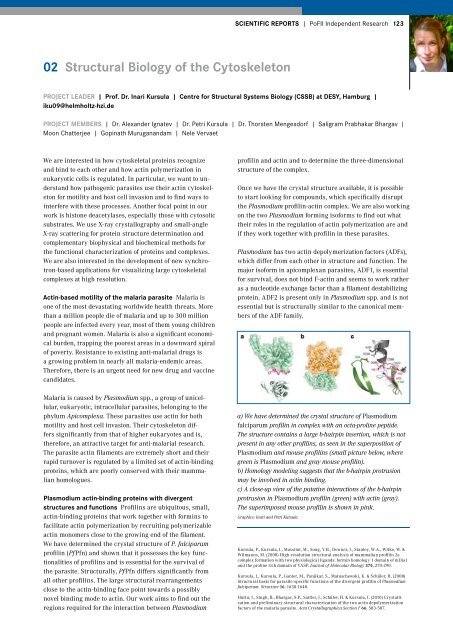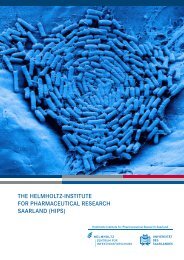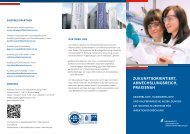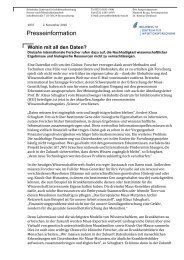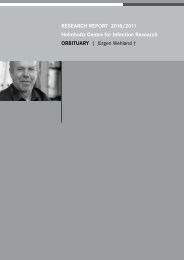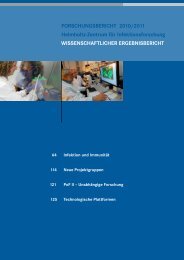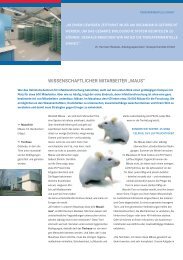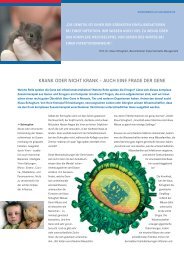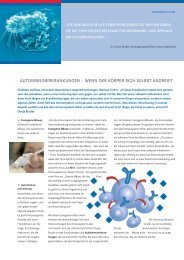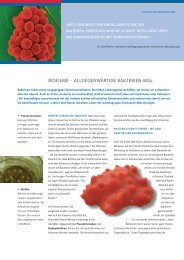Research Report 2010 2011 - Helmholtz-Zentrum für ...
Research Report 2010 2011 - Helmholtz-Zentrum für ...
Research Report 2010 2011 - Helmholtz-Zentrum für ...
Create successful ePaper yourself
Turn your PDF publications into a flip-book with our unique Google optimized e-Paper software.
SCIENTIFIC REPORTS | PoFII Independent <strong>Research</strong> 123<br />
02 Structural Biology of the Cytoskeleton<br />
PROJECT LEADER | Prof. Dr. Inari Kursula | Centre for Structural Systems Biology (CSSB) at DESY, Hamburg |<br />
iku09@helmholtz-hzi.de<br />
PROJECT MEMBERS | Dr. Alexander Ignatev | Dr. Petri Kursula | Dr. Thorsten Mengesdorf | Saligram Prabhakar Bhargav |<br />
Moon Chatterjee | Gopinath Muruganandam | Nele Vervaet<br />
We are interested in how cytoskeletal proteins recognize<br />
and bind to each other and how actin polymerization in<br />
eukaryotic cells is regulated. In particular, we want to understand<br />
how pathogenic parasites use their actin cytoskeleton<br />
for motility and host cell invasion and to find ways to<br />
interfere with these processes. Another focal point in our<br />
work is histone deacetylases, especially those with cytosolic<br />
substrates. We use X-ray crystallography and small-angle<br />
X-ray scattering for protein structure determination and<br />
complementary biophysical and biochemical methods for<br />
the functional characterization of proteins and complexes.<br />
We are also interested in the development of new synchrotron-based<br />
applications for visualizing large cytoskeletal<br />
complexes at high resolution.<br />
Actin-based motility of the malaria parasite Malaria is<br />
one of the most devastating worldwide health threats. More<br />
than a million people die of malaria and up to 300 million<br />
people are infected every year, most of them young children<br />
and pregnant women. Malaria is also a significant economical<br />
burden, trapping the poorest areas in a downward spiral<br />
of poverty. Resistance to existing anti-malarial drugs is<br />
a growing problem in nearly all malaria-endemic areas.<br />
Therefore, there is an urgent need for new drug and vaccine<br />
candidates.<br />
Malaria is caused by Plasmodium spp., a group of unicellular,<br />
eukaryotic, intracellular parasites, belonging to the<br />
phylum Apicomplexa. These parasites use actin for both<br />
motility and host cell invasion. Their cytoskeleton differs<br />
significantly from that of higher eukaryotes and is,<br />
therefore, an attractive target for anti-malarial research.<br />
The parasite actin filaments are extremely short and their<br />
rapid turnover is regulated by a limited set of actin-binding<br />
proteins, which are poorly conserved with their mammalian<br />
homologues.<br />
Plasmodium actin-binding proteins with divergent<br />
structures and functions Profilins are ubiquitous, small,<br />
actin-binding proteins that work together with formins to<br />
facilitate actin polymerization by recruiting polymerizable<br />
actin monomers close to the growing end of the filament.<br />
We have determined the crystal structure of P. falciparum<br />
profilin (PfPfn) and shown that it possesses the key functionalities<br />
of profilins and is essential for the survival of<br />
the parasite. Structurally, PfPfn differs significantly from<br />
all other profilins. The large structural rearrangements<br />
close to the actin-binding face point towards a possibly<br />
novel binding mode to actin. Our work aims to find out the<br />
regions required for the interaction between Plasmodium<br />
profilin and actin and to determine the three-dimensional<br />
structure of the complex.<br />
Once we have the crystal structure available, it is possible<br />
to start looking for compounds, which specifically disrupt<br />
the Plasmodium profilin-actin complex. We are also working<br />
on the two Plasmodium forming isoforms to find out what<br />
their roles in the regulation of actin polymerization are and<br />
if they work together with profilin in these parasites.<br />
Plasmodium has two actin depolymerization factors (ADFs),<br />
which differ from each other in structure and function. The<br />
major isoform in apicomplexan parasites, ADF1, is essential<br />
for survival, does not bind F-actin and seems to work rather<br />
as a nucleotide exchange factor than a filament destabilizing<br />
protein. ADF2 is present only in Plasmodium spp. and is not<br />
essential but is structurally similar to the canonical members<br />
of the ADF family.<br />
a) We have determined the crystal structure of Plasmodium<br />
falciparum profilin in complex with an octa-proline peptide.<br />
The structure contains a large b-hairpin insertion, which is not<br />
present in any other profilins, as seen in the superposition of<br />
Plasmodium and mouse profilins (small picture below, where<br />
green is Plasmodium and gray mouse profilin).<br />
b) Homology modeling suggests that the b-hairpin protrusion<br />
may be involved in actin binding.<br />
c) A close-up view of the putative interactions of the b-hairpin<br />
protrusion in Plasmodium profilin (green) with actin (gray).<br />
The superimposed mouse profilin is shown in pink.<br />
Graphics: Inari and Petri Kursula<br />
Kursula, P., Kursula, I., Massimi, M., Song, Y.H., Downer, J., Stanley, W.A., Witke, W. &<br />
Wilmanns, M. (2008) High-resolution structural analysis of mammalian profilin 2a<br />
complex formation with two physiological ligands: formin homology 1 domain of mDia1<br />
and the proline rich domain of VASP. Journal of Molecular Biology 375, 270-290.<br />
Kursula, I., Kursula, P., Ganter, M., Panjikar, S., Matuschewski, K. & Schüler, H. (2008)<br />
Structural basis for parasite-specific functions of the divergent profilin of Plasmodium<br />
falciparum. Structure 16, 1638-1648.<br />
Huttu, J., Singh, B., Bhargav, S.P., Sattler, J., Schüler, H. & Kursula, I. (<strong>2010</strong>) Crystallization<br />
and preliminary structural characterization of the two actin depolymerization<br />
factors of the malaria parasite. Acta Crystallographica Section F 66, 583-587.


